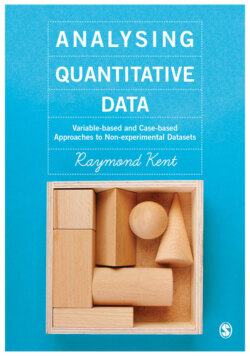Читать книгу Analysing Quantitative Data - Raymond A Kent - Страница 44
Upgrading or downgrading measures
ОглавлениеResearchers sometimes upgrade the complexity of the measures achieved by some of their variables in order to apply the more sophisticated statistical techniques that thereby become available. The most usual transformation is for sets of ordered categories to be upgraded to metric measures. There are two main ways in which this may be accomplished. The researcher may allocate numeric codes to ordinal categories in such a way that they can be treated as if they are metric. An example of this is a summated rating scale such as the one illustrated in Figure 1.2. This process, however, assumes that the ‘distances’ between each value are equal so that, for example, the distance between ‘Very important’ and ‘Quite important’ is the ‘same’ as the distance between ‘Quite important’ and ‘Neither important nor unimportant’. Such an assumption may seem reasonable in this example. It also tends to be reasonable for Likert items (see Chapter 1) where respondents are being asked about their degree of agreement or disagreement with a number of statements. However, for levels of satisfaction, where a set of categories like ‘Very satisfied’, ‘Fairly satisfied’ and ‘Dissatisfied’ have been used, this assumption is suspect since the ‘distance’ between ‘Dissatisfied’ and ‘Fairly satisfied’ is probably much greater than the ‘distance’ between ‘Fairly satisfied’ and ‘Very satisfied’. In any event, it would be unwise to treat average scores in any absolute sense. Thus an average score of, say, 4.0 for males and 2.0 for females does not mean that males are ‘twice’ as satisfied, or that they are two ‘units of satisfaction’ above the females. All we can say is that the average of the males is higher than that of the females. However, for measuring change, for example from one week to the next, then changes in the average scores are likely to reflect real changes in people’s level of interest.
The other way to create metric measures is to define categories of an ordered set in terms of counting numbers of instances as a measure of size. Thus a distinction between ‘Small’, ‘Medium’ and ‘Large’ organizations is only an ordinal distinction. However, if the researcher defined ‘Small’ organizations as having fewer than 50 employees, ‘Medium’ as having between 50 and 200 employees, and ‘Large’ as having over 200 employees then a discrete metric variable has been created, the ‘metric’ in this case being size measured by the number of employees. With a larger number of categories, more precisely defined, with upper and lower limits, it becomes possible to calculate an average size. This procedure is fine provided there is accurate information, for example, in the situation above, on the number of employees in each organization of interest. By creating (or assuming the creation of) metric measures, the researcher can now, for example, add up and then calculate average scores, calculate standard deviations and use the variables in ways that will be explained in Chapters 4–6.
There are some circumstances when a researcher may downgrade a measure and treat it as if it were at a less complex level. Thus a metric variable may be treated as ranked by ignoring the distances between categories. A class test out of 100 may be used to create ranks of first, second, third, and so on. This may be undertaken by the researcher either because he or she feels that the assumptions of the original metric are unwarranted, or because the variable concerned is to be correlated with another ranked variable and the researcher wants to apply a statistic that requires two ranked variables. Metric variables can be ranked in SPSS using the procedure Transform|Rank Cases.
Another example of downgrading is when a researcher wishes to crosstabulate a nominal with an ordered category variable. An appropriate coefficient may be chosen that treats both variables as nominal, thereby ignoring the ordering of the categories in one of the variables. A more extreme example is when a researcher takes a continuous metric variable like age and groups respondents into a binary measure of ‘old’ and ‘young’ or into an ordered category measure of ‘old’, ‘middle aged’ and ‘young’. This may be undertaken if the researcher wishes to crosstabulate age with another binary, nominal or ordered category variable, for example ‘purchased’ and ‘did not purchase’ a newspaper in the last seven days. The age split would normally be done in a way that creates two (or three or more as required) roughly equal groups. The SPSS procedure Transform|Compute can be used to create a new variable grouped in this way.
